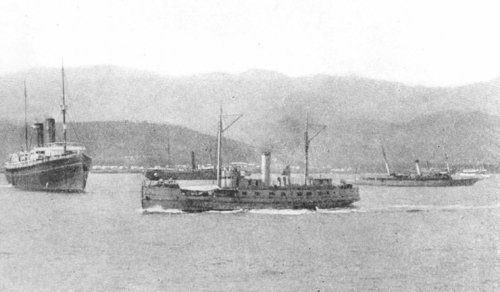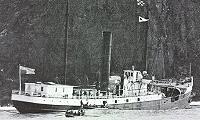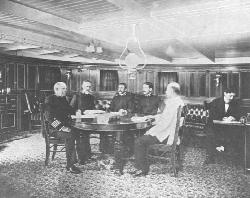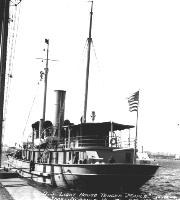


USLHT (United States Lighthouse Tender) SUWANNEE off Siboney, published in the book War in Cuba. In the background are auxiliary cruiser USS ST LOUIS (left) and armed yacht USS VIXEN (right).
The U.S. Lighthouse Service (LHS) was created on 7 August 1789 and placed under the Treasury Department. Before that time, each state had built and operated its own navigational aids. With the establishment of the Lighthouse Service, the Federal government paid the cost of operations and by 1797 all lighthouses were under Federal control. The Service was transferred to the Commerce and Labor Department in 1910. In 1939, under the President Roosevelt's Reorganization Plan No. II, approved 7 June and effective 1 July, it was provided "that the Bureau of Lighthouses in the Department of Commerce and its functions be transferred to and consolidated with and administered as a part of the Coast Guard." At the time of the Spanish American War, the Lighthouse Service was organized into twelve numbered regions called Lighthouse Districts (LHD). Each district was headed by a District Inspector and assisted by a District Engineer, both being officers of the Navy or the Army. The Commander of the Flying Squadron during the war, Commodore Winfield Scott Schley, is an example of this inter-relationship, having served as a Lighthouse Inspector 1879-1883 and 1892-1895. He was also Chairman of the Lighthouse Board in 1897-1898 until his promotion to Commodore.
Lighthouse tenders operated under the various district offices under the overall direction of the Superintendent of Lighthouses. Analogous to the Coast Guard buoy tenders of today, these vessels were tasked to place, repair and move floating navigational aids, deliver fuel, supplies and materials, transport construction and repair personnel to different stations, and transport LHS officers on official business. They also performed police duties such as assisting in smuggling prevention and protection of government property.
Along with the Revenue Cutter Service, the Lighthouse Service was placed under the direction of the Navy by Executive Order as tensions with Spain increased and the clamor for war grew. The lighthouse tenders operated for the Navy in much the same manner as they did for the LHS, hauling material, supplies and people and engaging in "police duties" (the blockade of Cuba). Four of these vessels saw active service off Cuba. They were armed with two to four light, rapid-fire guns, probably 3- and 6-pounders (guns firing shells weighing 3 and 6 pounds, respectively). These provided sufficient defense against the smaller Spanish gunboats and unarmed merchant ships they might be expected to encounter.
The following is a list of lighthouse tenders that served with the Navy during the war. If you have more information on a listed vessel (or a vessel not listed), let us know!
|
|
|
|
|
|
|
|
|
|
|
|
|
|
|
|
|
|
|
|
 Propulsion: independent vertical compound
steam engines, coal fired boilers, twin screw, 1350 HP. Built as a
tender for the Atlantic and Gulf Coasts and first homeported at New
York, NY in the 3rd Lighthouse District (LHD).
Propulsion: independent vertical compound
steam engines, coal fired boilers, twin screw, 1350 HP. Built as a
tender for the Atlantic and Gulf Coasts and first homeported at New
York, NY in the 3rd Lighthouse District (LHD).
ARMERIA was built at a cost of $178,930.09.
ARMERIA was assigned to the Navy from 5 May to 16 September and converted for naval service at the Norfolk Navy Yard, commanded by Lieutenant Commander Leavitt Curtis Logan. Assigned to the North Atlantic Squadron for the duration of hostilities, she made at least two voyages from the United States to Cuba carrying ammunition for the Army.
In early June, ARMERIA was part of the Spanish "ghost squadron" that delayed the sailing of General Shafter for six days. USS EAGLE (a converted yacht) reported the presence of Spanish ships off the north coast of Cuba. Sailing of the American expeditionary force was delayed pending arrival of additional escorts from the blockading ships off Santiago. The sighted ships turned out to be ARMERIA, along with USS SCORPION and the storeship SUPPLY. In response to an urgent request from the Navy Department, Admiral Sampson decided to confirm that all Spanish ships were in Santiago Bay, leading to another exploit by the Lighthouse Service (see USLHT SUWANNEE, below)
ARMERIA was reassigned to the 13th Lighthouse District in 1907 and transferred again to the 16th Lighthouse District at Kechikan in 1911, becoming the first tender to be permanently assigned to Alaska. She struck a submerged uncharted rock while servicing Cape Hinchinbrook Light on 20 May 1912 and wrecked. Considered a total loss, her hulk was sold at auction.
In the photo at left, the reader may note that the she is flying an
inverted U.S. flag. This is a distress signal. This image shows the
ship at rest where it hit the uncharted rock. the crew is being
removed.
|
|
|
|
|
|
|
|
|
|
|
|
|
|
|
|
|
|
|
|
Propulsion: two compound inverted reciprocating steam engines, two Page Burton watertube coal fired boilers, twin 4-bladed screws, 650 SHP. MANGROVE was assigned to the 7th LHD at Key West FL.
The vessel was built at a cost of $74,997.63 and completed in 1897.
 After the explosion aboard USS
MAINE, MANGROVE brought back the surviving wounded to Key
West. She later brought back MAINE's guns
that were salvaged, along with civilians leaving Cuba at the start
of the Spanish-American War. She also served as a site for the Navy
Court of Inquiry concerning the explosion. MANGROVE served with the
Navy until 18 August and had a brush with a small Spanish gunboat at
Caibarien, Cuba. The vessel was cited by the Navy for "Conspicuous
Service."
After the explosion aboard USS
MAINE, MANGROVE brought back the surviving wounded to Key
West. She later brought back MAINE's guns
that were salvaged, along with civilians leaving Cuba at the start
of the Spanish-American War. She also served as a site for the Navy
Court of Inquiry concerning the explosion. MANGROVE served with the
Navy until 18 August and had a brush with a small Spanish gunboat at
Caibarien, Cuba. The vessel was cited by the Navy for "Conspicuous
Service."
At right, members of the Navy Court of Inquiry examining Ensign Wilfrid V. Powelson, on board the USLHT MANGROVE, in Havana Harbor, Cuba, circa March 1898. Those seated around the table include (from left to right): Captain French E. Chadwick, Captain William T. Sampson, Lieutenant Commander William P. Potter, Ensign Powelson, Lieutenant Commander Adolph Marix. (Photograph from Uncle Sam's Navy, 12 April 1898).
MANGROVE served as a patrol boat throughout World War I, being
returned to the Lighthouse Service 1 July 1919. In 1922, she was
assigned to a permanent station in the 6th LHD at Charleston, S.C.
During World War II, Mangrove continued as a buoy tender (USCGC
MANGROVE, WAGL 232) until 1 January 1946, when she returned to the
Treasury Department. She was decommissioned 22 August 1946 and was
sold 6 May 1947.
|
|
|
|
|
|
|
|
|
|
|
|
|
|
|
|
|
|
|
|
 Propulsion: two compound fore and aft steam
engines, two Scotch coal fired boilers, twin 4-bladed screws, 650
HP. MAPLE was first assigned to the 5th LHD at Baltimore MD.
Propulsion: two compound fore and aft steam
engines, two Scotch coal fired boilers, twin 4-bladed screws, 650
HP. MAPLE was first assigned to the 5th LHD at Baltimore MD.
The vessel was built at a cost of $93,888.90, when the vessel was completed, she was immediately taken over by the navy.
The picture at right shows MAPLE at the Norfolk Navy Yard 9 May during her conversion for duty with the Navy. Clearly shown are two of of the rapid-fire guns with which she was armed. During the war, MAPLE operated with the blockading forces off Cuba until 20 September, 1898, during which she was cited by the Navy for "Conspicuous Service."Following the war, she was then repaired and returned to LHS duty 6 February 1899.
During World War I, MAPLE was assigned to the 5th Naval
District, performing patrol duties off Norfolk, Va., until 1 July
1919 when she was returned to the U.S. Lighthouse Service. MAPLE
was sold 29 October 1933 to the McLain Caroline Line, Inc., New
York, N.Y. Her engines were removed and she operated as barge
named variously McLAIN No. 300, NICHOLS No. 6, etc. until
1948. She was dismantled on 1949.
|
|
|
|
|
|
|
|
|
|
|
|
|
|
|
|
|
|
|
|
 Propulsion: two Steeple compound
inverted reciprocating steam engines, two Almy watertube coal
fired boilers, twin screws, 650 HP.
Propulsion: two Steeple compound
inverted reciprocating steam engines, two Almy watertube coal
fired boilers, twin screws, 650 HP.
The vessel was built at a cost of $74,872.07.
MAYFLOWER began service with the Navy on 27 April, being renamed SUWANNEE to avoid confusion with the converted yacht USS MAYFLOWER (later the Presidential yacht), and served until 23 September. This vessel was involved in several actions along the Cuban coast and was cited by the Navy for "conspicuous service."
On 11 June, Lieutenant Victor Blue of SUWANNEE went ashore to make a visual reconnaissance of Santiago Bay and the ships in it. Guided by a member of the Cuban insurgent forces, he passed through enemy lines and observed the Spanish squadron on 12 June. His report confirmed that all of Admiral Cervera's squadron had in fact entered the bay, thus enabling the blockade by heavy ships of the Navy to be concentrated at that point, without having to worry about threats to the troop convoys preparing to depart from Tampa. SUWANNEE's night station among the blockading forces was two miles from Morro Castle as part of a picket line to detect any sortie by FUROR and PLUTON for a torpedo attack. She missed the battle, however, being one of the ships detached to Guantanamo bay for coaling at the time.
On 15 June, USS TEXAS, USS MARBLEHEAD and SUWANNEE provided gunfire support for Marines engaged in consolidating the American position at Guantanamo Bay, which had been seized 10 June for use as a secure location for coaling rendezvous and refuge from foul weather. SUWANNEE again provided gunfire support, along with USS NEW YORK and USS GLOUCESTER, on 1 July for the Army troops advancing on Aguadores.
From the Annual Report of the Secretary of the Navy: "On the 12th of August the NEWARK, accompanied by the RESOLUTE, carrying the First Battalion of Marines, and the SUWANEE, HIST, OSCEOLA, and ALAVARADO, proceeded to Manzanillo, where a demand for the surrender of the place was made. This refused, the place was bombarded. At daylight on the morning of the 13th a large number of white flags were seen floating from the block houses and batteries, and a boat came out from the shore carrying a flag of truce. The captain of the boat delivered to the senior officer present the cipher dispatch of the Department stating that the President had signed the protocol of peace and had proclaimed an armistice."
Upon returning to the USLHS, in December, 1898, she regained her original name and was assigned to the 2nd LHD at Boston. She patrolled off the Atlantic coast during World War I and in 1924 was transferred to the 5th Lighthouse District. Decommissioned in December 1939, MAYFLOWER was transferred to the Maritime Training Service at Boston. In July of 1940 she was recommissioned as USCGC Mayflower (WAGL-236) and relocated to Norfolk. On August 15, 1943 her name was changed to USCGC HYDRANGEA to again avoid a naming conflict with USS MAYFLOWER (also back in the Navy again as a patrol craft). She decommissioned 8 October 1945 and was turned over to the Maritime Commission for disposal.
(As a service to our readers, clicking on book title in red will take you to that book on Amazon.com)
Coast Guard History Page, US Lighthouse Service (http://www.laesser.org/light/tenders/uslht.htm)Mooney, James L., ed., Dictionary of American Naval Fighting Ships, Washington, DC, Government Printing Office, 1959, 1969
Naval Historical Center, Spanish American War (http://www.history.navy.mil/wars/index.html)
Navy Department, Annual Reports of the Secretary of the Navy, 1898. Washington, DC, Government Printing Office, 1898
Peterson, Douglas, United States Lighthouse Service Tenders, 1840-1939. Annapolis: Eastwing Publishing, 2000 (p. 60, 66, 70, 71).
Trask, David F. The War With Spain in 1898 . New York, NY, MacMillan, 1981.
Weiss, George, The Lighthouse Service: Its History, Activities and Organization, Baltimore, MD, The Johns Hopkins Press, 1926